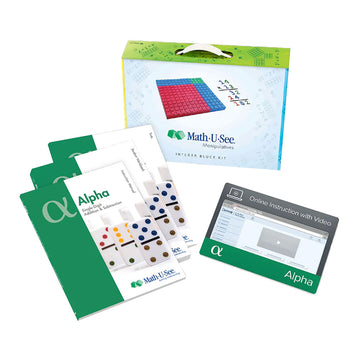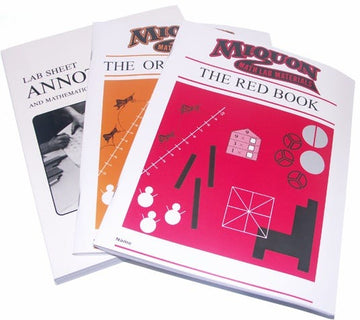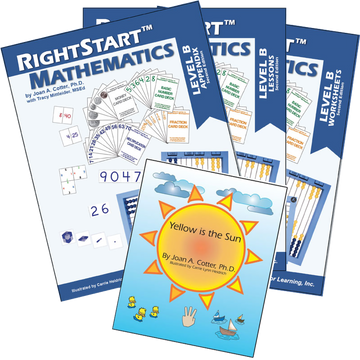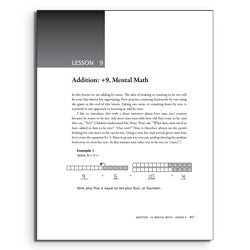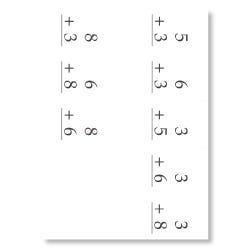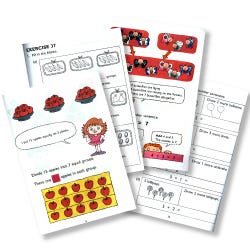1st Grade Math
Are you the parent of a first grader? You are probably wondering what kind of math a child needs to know at this grade. This guide lists the best first grade math curriculum choices, tells you what a first grader should be able to do with math, and provides tips for teaching first grade math.
Math Curriculum for First Graders
There are six excellent choices for first grade math curriculum. While they vary in approach, they all provide your first graders with the firm foundation they need for math instruction in their first formal year of schooling. See the complete scope and sequence of each of these trusted math programs here.
$125.40
$120.00
$232.55
$78.53
If you’re not sure that first grade math is the right level for your child, use the math placement tests here to confirm the best level.
1 Math-U-See Alpha
Math U See’s Alpha level is for first graders. At this level, students focus on building a solid foundation for single digit addition and subtraction. The colorful integer blocks that are integrated into the program bring math alive to young learners. The blocks form a visual picture of the math fact that helps cement concepts. The short video lesson can be watched by the instructor or together with the student. There is ample practice provided without the overkill of excessive busywork.
2 Horizons 1 Math Program
In Horizons Math for first graders, your child will count 1-100 with a variety of number sets; count by 1's from 100-200; learn ordinal and cardinal numbers; add vertically and horizontally carrying in 1's column; subtract vertically and horizontally without borrowing; and understand basic fractions, sets, shapes, graphs and units of measure.
3 Saxon Math 1 Program
With the Saxon Math approach, all new concepts are developed through hands-on activities and rich mathematical conversations that actively engage students in the learning process. Concepts are developed, reviewed, and practiced over time.
Saxon Math 1 is the program for first grade. It continues to build on skip counting by 2s, 5s, 10s, and 100s. Your student will continue to work on recognizing numbers with up to four digits. Place value is stressed as well as the identification of numbers coming before and after. Sets are compared using more than, fewer than, and the same. Numbers are classified as even or odd. Addition and subtraction continue to be taught. The concepts of multiplication and division are introduced. Students are encouraged to draw pictures and models to solve story problems.
4 Singapore 1 Math Program
Using the Singapore 1 Math Textbook, the instructor introduces the student to concepts including ordinal numbers, place value, more than, less than, and equal to. The student will learn to recognize number patterns and addition and subtraction as inverse operations. Singapore focuses on mental math using number bonds to help students quickly make computations. After the instruction from the textbook, your student will practice the concepts in a student workbook.
5 RightStart Math Level B
Right Start Math makes learning math facts fun! With its hands-on abacus and interactive games, students will continue mastering their addition and subtraction facts through eighteen. First graders should use the RightStart Math Level B Book Bundle. In it, your first grader will encounter geometry concepts as well as lessons on time and money.
6 Miquon Math First/Second Grade
Miquon is a discovery-based program which emphasizes patterns and mathematical relationships over memorization or using formulas. Cuisenaire Rods are an integral part of this first grade math program, helping students discover the concepts while working though the Lab Sheets (worksheets). The teacher, using the Lab Sheet Annotations, guides the student through this process of discovery.
For the earliest level of Miquon, there are two workbooks (orange and red) and students must start in the orange book no matter their age or grade. In these first two workbooks, students will cover the basics of counting and one-to-one correspondence. They will also be introduced to all four basic functions (addition, subtraction, multiplication, division), number lines/functions, equalities/inequalities, and geometric recognition. Also included is a bit about length/area/volume, using number lines, equalities/inequalities, clock arithmetic, and factoring.
With Miquon, the work is student-paced without defined daily lessons.
First Grade Math Lessons
First Grade math lessons should focus on helping your student master basic addition and subtraction facts with fluency. You want the answers to come automatically, but it will take time and much repetition. So be patient with your first grader. Lessons should be short so as to not overwhelm your new learner. Place the emphasis on the quality of your math lessons, not quantity. You are laying the foundation, so be sure to keep math upbeat and low stakes—like an enjoyable game! If you need to slow the pace as you work through your first-grade math curriculum, that’s fine!
First Grade Math Reference Sheet
While there aren’t any math formulas used in first grade, there are important concepts to learn! Use these printable reference charts and printable templates for your first grader.
- basic geometric figures: circle, triangle, square, rectangle
- coins: penny, nickel, dime, quarter
- A blank number line and clock face
First Grade Math
Problems & Equations
Math for first graders may include problems covering the topics below
- Skip counting by 2s, 5s, and 10s
- Recognizing place value up to 100s
- Identifying basic geometric shapes
- Telling time
- Money
- Using a number line to solve addition and subtraction equations
- Short story problems using models, hands on manipulatives, and pictures
- Finding square roots
- Understanding and correctly applying inverse operations
- Least Common Multiple (LCM) and Greatest Common Factor (GCF)
- Recognizing equivalent fractions
- Using estimation skills to evaluate the reasonableness of an answer
- Solving Word Problems involving distance, rate, and time
- Unit Conversions
- Ratios
- Recognizing and classifying geometric figures
- Finding perimeter, area, and volume of geometric figures
- Classifying angles, solving for unknown angles
- Working with time and currency
- Probability and Statistics
First Grade Math
Numbers & Operations
As students grow in their understanding of numbers, they begin to develop strategies for solving more complex problems. In addition to memorizing facts, first graders should be encouraged to apply their newly acquired knowledge to real world situations. Encourage your student to try different ways to solve problems. At this stage, children are still very much bound to the concrete world, so encourage the use of tangible objects that give children things to manipulate as they experiment with math.
First Grade Math
Pre-Algebra & Algebra
As first graders master math facts, they can begin to think algebraically. Once a student understands that 2 + 3 = 5, they can move to solving 2 + ? = 5. A gentle exposure to these pre-algebra concepts nurtures success in higher levels of math.
First Grade Math Games
Math games are easy to incorporate into everyday life. Ask your child to find 4 + 2 red items at the park, ask them to take 9 - 4 bites of dinner. You can encourage your students to use their new found math skills in many playful ways.
First Grade Math Standards
If you are looking for a program that follows the common core standards, both Math U See and Saxon Math fit. Be advised that while these programs do cover the standards, they are often organized in a different order from the prescribed outline. If you would like to know what your state requires, check with your state board of education. You can see the common core standards for first grade here.
First Grade Math State Tests
First grade students who are enrolled in public school may take a variety of standardized tests. Many of these are benchmark tests that allow the school to track the progress of individual students as well as the group as a whole. The best way to see if your state requires testing for first grade is to check the state homeschool regulations. The 2015 Every Student Succeeds Act does not require testing in first grade.
First Grade Math Vocabulary
Some terms that your first grader should be familiar with include:
- Addition/Subtraction
- Sum/Difference
- Addend
- Less than
- Greater than
- Equal
- Circle
- Square
- Rectangle
- Triangle
- Prism
- Hour, Minute, Second

The L. Family, Sonlighters from Postville, IA
First Grade Math Materials, Supplements, and Manipulatives
If you are looking to boost your first grader’s math by supplementing, consider one of these fun extras.
$24.99
$24.00
1 MathTacular!
Join Justin as he presents math concepts in a fun and funny way. Use this DVD to strengthen understanding of a specific concept or to improve a child’s attitude towards math. There are over four hours of content which you can stream or watch from the DVD. Topics covered include time, place value, adding, subtracting, money, and more.
2 Life of Fred
Join five-year-old Fred as he goes about his daily routine and uses math to help him. This hardback book covers topics including days of the week, geometric shapes, telling time, skip counting, addition, subtraction, and other concepts. As a bonus, your student will also encounter geography, history, and science all in a fun way. Here is a sneak peak of some of Fred’s silly adventures.
